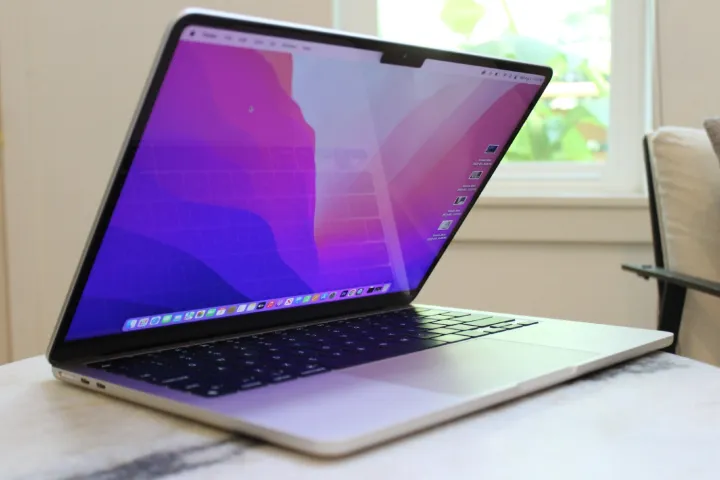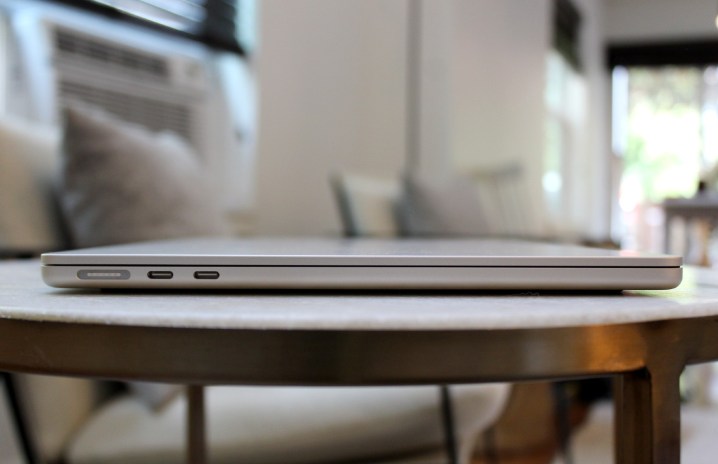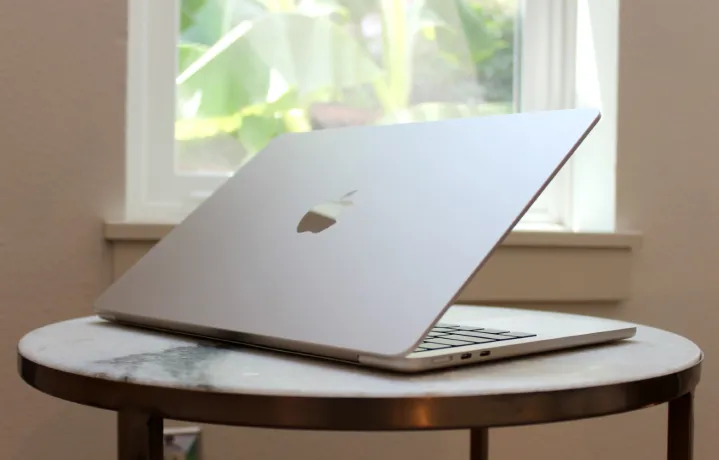
Apple’s MacBook Air M2 sits at the top of our list of best laptops, and for good reason. It’s incredibly well-built, exuding an elegance that few laptops can match. It’s also plenty fast for productivity users, and its GPU is optimized for creators. It’s keyboard, touchpad, and display are all top-notch.
Enter the MacBook Air M3. The upgraded chipset offers even faster performance, particularly in GPU-intensive apps, and the M3 model supports an additional external display. It’s $100 more, but is that uptick in price justified? Let’s dig in.
Specs and configurations
| Apple MacBook Air M3 | Apple MacBook Air M2 | |
| Dimensions | 11.97 inches x 8.46 inches x 0.44 inches | 11.97 inches x 8.46 inches x 0.44 inches |
| Weight | 2.7 pounds | 2.7 pounds |
| Processor | Apple M3 (8-core) | Apple M2 (8-core) |
| Graphics | 8 GPU cores 10 GPU cores |
8 GPU cores 10 GPU cores |
| RAM | 8GB 16GB 24GB |
8GB 16GB 24GB |
| Display | 13.6-inch 16:10 Liquid Retina IPS 2560 x 1664 | 13.6-inch 16:10 Liquid Retina IPS 2560 x 1664 |
| Storage | 256GB SSD 512GB SSD 1TB SSD 2TB SSD |
256GB SSD 512GB SSD 1TB SSD 2TB SSD |
| Touch | No | No |
| Ports | 2 x USB-C with Thunderbolt 4 1 x 3.5mm audio jack |
2 x USB-C with Thunderbolt 4 1 x 3.5mm audio jack |
| Wireless | Wi-Fi 6E and Bluetooth 5.3 | Wi-Fi 6 and Bluetooth 5.3 |
| Webcam | 1080p | 1080p |
| Operating system | MacOS Sonoma | MacOS Sonoma |
| Battery | 52.6 watt-hours | 52.6 watt-hour |
| Price | $1,099+ | $999+ |
| Rating | Not yet reviewed | 4 out of 5 stars |
The Apple MacBook Air M3 maintains the previous pricing of the M2 model it replaces. That means it starts at $1,099 for a base M3 chipset, 8GB of RAM, and a 256GB SSD. MacBooks perform better with 16GB of RAM, which is a $200 upgrade, and the 256GB SSD uses slower memory than the 512GB and larger SSDs, which carry at least a $200 cost. Fully configured, the MacBook Air M3 is $2,299 for an upgrade M3, 24GB of RAM, and a 2TB SSD.
The MacBook Air M2 replaces the M1 model as the entry-level MacBook, but with a price drop. It’s now priced at $999 for a base M2, 8GB of RAM, and a 256GB SSD. The same caveats apply regarding RAM and storage. Fully configured, the higher-end MacBook Air M2 costs $2,199.
You can save $100 by going with the MacBook Air M2, and it’s a great choice for the budget-conscious buyer. However, anyone who wants the upgraded CPU and GPU performance of the M3 will find their money well-spent.
Display and ports

Both laptops offer the same display, a 13.6-inch IPS display running at 2560 x 1664 and pumping out up to 500 nits of brightness. In our testing of the MacBook Air M2, the display provided very good color width at 100% of sRGB, 90% of Adobe RGB, and 100% of DCI-P3, with very good accuracy at a Delta-E of 1.08 (1.0 or less is indistinguishable to the human eye). The MacBook Air M3’s display is likely to provide the same high quality image.
One very important change to the MacBook Air M3 is its support for two external displays when the lid is closed. That’s a significant improvement over the MacBook Air M2, which only supported one external display with the lid open or closed. While the MacBook Air M3 is also limited to a single external display when the built-in display is in use, the ability to use two high-resolution (up to 5K at 60Hz) displays when the lid is closed will please those who want more screen real estate. For some people, that alone is a reason to spend extra money on the new model.
It should be noted that if you open the lid of the M3 MacBook Air, it will automatically shut off one of your external monitors. As noticed by Marques Brownlee, that means you won’t be able to use the MacBook Air keyboard and touchpad in this setup — you’ll need to use external peripherals.
I’ll also mention wireless connectivity here, as it’s one of the only other changes between these two laptops. The M3 MacBook Air gets the upgrade to Wi-Fi 6E, whereas the M2 is still on Wi-Fi 6. It’s not a huge difference, but rather some future-proofing to make sure you get the highest internet speeds if you plan to upgrade your router anytime soon.
Performance

Of course, the most significant change is the Apple Silicon M3 chipset upgrade, which provides a significant uptick in performance thanks to a switch to a 3nm process. We’ll need to wait to test the newest MacBook Air to see how significant the upgrade is, but the M3 has demonstrated speed improvements in the iMac M3 compared to the iMac M1. Apple quotes a 15% improvement in each M3 performance core over the M2, which should translate to some extra oomph in CPU-intensive tasks.
The more significant upgrade, though, is to the M3’s GPU. Apple built in hardware mesh shading support and ray tracing, which, when combined with the new Dynamic Caching memory system, should provide faster performance in gaming and creative apps that can use the GPU. The company says the new chipset’s graphics provide up to 60% faster frame rates in No Man’s Sky over the M1, and up to a 60% improvement in Final Cut Pro.
Finally, the M3 has a faster 16-core Neural Engine that should help speed up AI functionality. That’s an increasingly important specification, and it makes the MacBook Air M3 more competitive with laptops using the Intel and AMD Neural Processing Units (NPUs).
Portability

Both laptops are very small and relatively light machines that will fit into any backpack and won’t wear you down. There’s no difference between the two in their portability.
The MacBook Air M2 has excellent efficiency, with some of the best battery life in a 13-inch laptop today. We saw 18 hours of web browsing and 21 hours looping our test video, which is twice as long as the Windows laptop average. You’ll get not just all-day longevity, but battery life that lasts well into a second day of typical use. We expect the MacBook Air M3 to be as good or better.
Design

The MacBook Air M3 retains the stunningly thin CNC-machine aluminum chassis at just 0.44 inches thick and weighing 2.7 pounds. The display bezels are small, thanks to a controversial notch in the display for the webcam, making for a pleasantly dense and very small laptop. The chassis is solid and exudes quality, while the lid is just the tiniest bit bendable. Note that the MacBook Air M3 also has a 15-inch model that’s also incredibly thin at 0.45 inches and light at 3.3 pounds.
The same colors are available as before, including Silver, Starlight, Space Gray, and Midnight. The MacBook Air M3 and M2 are therefore identical in appearance — and gorgeous. Few laptops offer the same elegance and fastidious design.
The Magic Keyboard remains in place with its large keycaps, plenty of key spacing, and the same snappy, precise switches that aren’t the deepest around, but are still the most comfortable. The Apple Force Touch haptic touchpad is the same size and provides the best haptics on a laptop thanks to the additional functionality provided by the Force Click feature.
Wired connectivity is the same as well, with the same dual USB-C ports with Thunderbolt 4 support and a 3.5mm audio jack. Power is provided by a MagSafe 3 connection that not only protects against accidental spills, but also keep the USB-C ports available when charging. The webcam is also unchanged, providing the same 1080p resolution and software tools.
The MacBook Air M3 is worth the $100 difference
The MacBook Air M2 is a great laptop for $999 if your budget is extremely tight. But frankly, the MacBook Air M3 offers enough of a performance increase to justify spending $100 more, and the ability to connect to an additional external display is a huge advantage.
We won’t tell you how to spend your money, but we believe the MacBook Air M3 is worth an additional C-note. It will likely take the older model’s place in our list of best laptops.
Editors’ Recommendations
Services Marketplace – Listings, Bookings & Reviews
